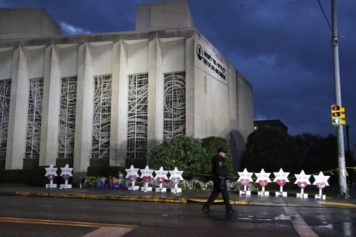The recent shooting at a Sikh temple in Oak Creek, Wisconsin has brought sudden attention to one of the most underground music scenes in America: hate rock. Wade M. Page, the man who killed six people and wounded three others in a shooting rampage on Sunday, was the front man of a white supremacist band called End Apathy and belonged to another called Definite Hate. In a 2010 interview posted to his record label’s web site, Page—who was shot and killed by police at the scene in Wisconsin—said he became involved with the white power music scene beginning in the early 2000s, and that he had occasionally filled in on guitar and bass for bands such as Celtic Warrior, Radikahl, Max Resist, Intimidation One, Aggressive Force, and Blue Eyed Devils. He also performed at hate rock fests across Europe.
Shortly after Sunday’s shooting, I spoke to the former singer of Intimidation One, one of the bands on Page’s list of collaborators. The singer said Page played bass and guitar for the band on a European tour in the late ‘90s. “I played over 200 shows with that dude,” said the singer. “He was one of the most mellow guys you could know, but he would get crazy when he was drunk.”
Though many Americans first learned of the white supremacist music scene via news about Page’s shooting spree, hate rock has been around since the 1980s, providing a rallying point for white supremacy and serving as a significant vehicle to advance the neo-Nazi movement. As a sociologist, I have spent most of my career studying the skinhead subculture, and as part of that research, I’ve had plenty of occasion to observe the hate rock music scene up close.
While their music is protected by the First Amendment, hate rock bands are unwelcome at most music venues, so a typical show takes place either in someone’s basement, at a so-called “white family picnic” held on the back 40 acres of someone’s private land, or as part of a white power music festival. (Hammerfest is one of the biggest; Page played the festival at least once.)
As Page’s hate-rock resume makes clear, the white power music scene is small, rudimentary, and made up of virtually interchangeable parts. Though members of the scene have made sporadic forays into epic “black metal” and even folk, most of the music is solidly punk rock, with minimal chord changes and lots of shouting. Hence it’s not exactly hard for someone like Page to fill in for another band—and it’s often necessary. Twenty years ago, when I was working on my doctorate by studying the skinhead subculture as an undercover researcher, I was abruptly drafted one night to sing onstage with a skinhead band after the lead singer had become too drunk to stand up. Since I knew a lot of old punk rock songs, I made do by steering the band towards covers of songs by non-racist punk bands like the Sex Pistols and the Ruts.
If the hate music scene has a geographic hub, it is in the post-industrial rust belt, where narratives of white decline have a particularly sour resonance. Two prolific distributors, Diehard Records and ISD Records, are both based in Ohio…
Read more:Randy Blazak, Pacific Standard


